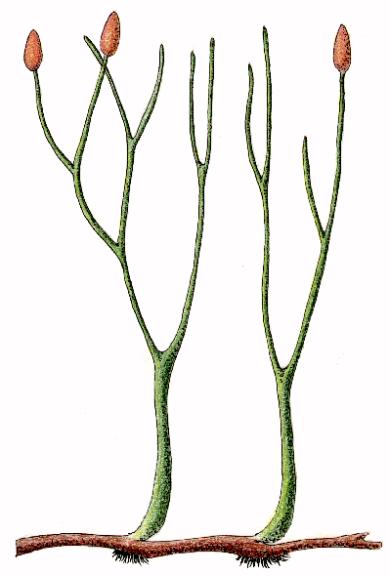
| Palaeos |  |
Tracheophyta |
| Plants | Aglaophyton |
| Page Back | Unit Back | Up | Unit Home | Glossary |
| Page Next | Unit Next | Down | Plants | Dendrogram |

At least one plant originally considered rhyniophytes (and hence primitive vascular plants) is now known not to belong in that group at all. Edwards (1986) found that the structures in Rhynia major the structures originally interpreted as tracheids in a central vascular strand turned out on closer examination to be conducting tubes more like those of some mosses, indicating this was probably not a true vascular plant, even though, like the rhyniophytes this plant lacked leaves and roots, and had terminal sporangia on branching axes. He therefore renamed it Aglaophyton major. It is believed that the gametophyte generation also had water-conducting tissue, cuticle, and stomata, making this species isomorphic.
This species is therefore either transitional between mosses and true vascular plants, or represent one of a number of experimental lineages that were evolving during the late Silurian and early Devonian (similar analogies of parallel straight-line evolution can be found among the early synapsids, where several lineages independently evolved towards the mammalian condition). These plants are therefore considered protracheophytes.
In any case, Aglaophyton major coexisted alongside primitive true vascular plants like Rhynia and Asteroxylon. All these plants have been found perfectly preserved in fossil form in the Rhynie Chert (Pragian epoch, Devonian period of Euramerica). They were among a variety of plants apparently growing together in an ancient community. Although very primitive, Aglaophyton major was a relatively large plant for this time, with branched aerial stems up to about 60 cm in height
The gametophyte of Aglaophyton appears to be Lyonophyton, another Rhynie Chert plant with naked axes and dichotomous branches; these branches terminate in antherida. Lyonophyton has some sort of conducting strand at the center of its axis, but the nature of the tubes is questionable. The two generations are linked together by shared epidermal features.
Aglaophyton was a common plant in the Rhynie ecosystem, and seems to have preferred growing on litter-covered, organic-rich surfaces. While occasionally found in monotypic stands it more often occurred with other species, particularly Nothia, Asteroxylon, Horneophyton and occasionally Rhynia. The cuticle and stomata display adaptations to prevent water loss, suggesting adaptation to drought-like conditions, although wet conditions may have been necessary for spore germination.
| Links |
![]() Edwards, DS, 1986. Aglaophyton major, a non-vascular land-plant from the Devonian Rhynie Chert. - Botanical Journal of the Linnean Society, 93: 173-204.
Edwards, DS, 1986. Aglaophyton major, a non-vascular land-plant from the Devonian Rhynie Chert. - Botanical Journal of the Linnean Society, 93: 173-204.
![]()
![]() Aglaophyton - from the Biota of Early Terrestrial Ecosystems: The Rhynie Chert - best on the web
Aglaophyton - from the Biota of Early Terrestrial Ecosystems: The Rhynie Chert - best on the web
![]() The Rhynie Flora--Elaborations on a Theme - Aglaophyton
The Rhynie Flora--Elaborations on a Theme - Aglaophyton
![]()
![]() The Rhynie Chert and its Flora - III. Rhynia and Aglaophyton - includes photographs showing details of microstructure
The Rhynie Chert and its Flora - III. Rhynia and Aglaophyton - includes photographs showing details of microstructure
![]()
![]() The Rhynie Chert and its Flora - VI. Growth Forms of Rhynia and Aglaophyton - includes
photographs showing details of microstructure
The Rhynie Chert and its Flora - VI. Growth Forms of Rhynia and Aglaophyton - includes
photographs showing details of microstructure
| Page Back | Page Up | Page Top | Page Next |